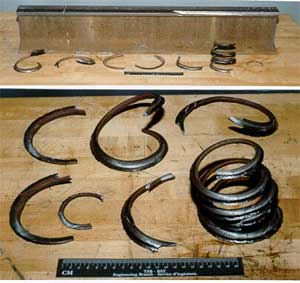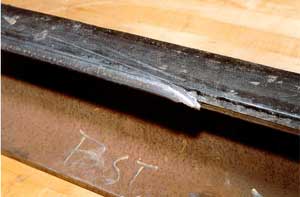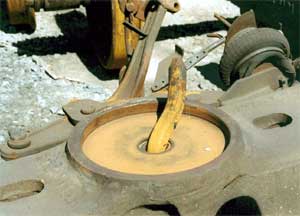Derailment
Canadian National train Q-137-11-28
Mile 1.67, Butler Spur
Saint-Hyacinthe Subdivision
Montréal, Quebec
The Transportation Safety Board of Canada (TSB) investigated this occurrence for the purpose of advancing transportation safety. It is not the function of the Board to assign fault or determine civil or criminal liability. This report is not created for use in the context of legal, disciplinary or other proceedings. See Ownership and use of content. Masculine pronouns and position titles may be used to signify all genders to comply with the Canadian Transportation Accident Investigation and Safety Board Act (S.C. 1989, c. 3).
Summary
On 29 August 2001, at approximately 1700 hours eastern daylight saving time, Canadian National Train Q-137-11-28, inbound from Halifax, Nova Scotia, was approaching the Turcot Yard, in Montréal, Quebec, when it derailed eight container cars at Mile 1.67 on the Butler Spur. Five containers rolled down the railway embankment, and came to rest partly obstructing Butler Street. There were no injuries.
Ce rapport est également disponible en français.
Factual information
Train Q-137-11-28 (train 137) departed Halifax, Nova Scotia, headed for Montréal, Quebec. It consisted of two locomotives and 86 cars (85 loaded and one empty). It was approximately 5900 feet long and weighed some 5200 tonnes. The train was composed of multi-platform container cars, each consisting of four or five permanently coupled platform, and single-platform container cars. The crew members, a locomotive engineer and a conductor, were qualified for their positions and met established fitness and rest standards.
The event recorder indicated that at 1710 hours eastern daylight saving time (EDT)Footnote 1, train 137 came to a stop at the beginning of the Butler Spur (Mile 72.1 of the Saint-Hyacinthe Subdivision), then accelerated to a speed of 12 mph. At Mile 2.0 of the spur, the train experienced a train-initiated application of the emergency brake and came to a stop.
The crew inspected the train and found that eight container cars had derailed. Five of the cars had fallen down the railway embankment, immediately to the east of the lower passage that straddles a Hydro-Québec access road; the three others remained upright on the railway right-of-way. Some containers broke away from their cars and obstructed Butler Street, which is adjacent to the track.
The Butler Spur is controlled by a Centralized Traffic Control System (CTC) in accordance with Canadian Rail Operating Rules (CROR), under the supervision of a Rail Traffic Controller (RTC) stationed in Montréal. The spur extends westward over a distance of 2.4 miles, starting at Mile 72.1 of the Saint-Hyacinthe Subdivision, and connects to the Montréal Subdivision at Mile 2.6. According to Transport Canada's (TC) Railway Track Safety Rules (RTSR), it is a "track other than a main track" (industrial spurs and yard tracks). The maximum speed limit is 25 mph for freight trains; however, in response to complaints from local residents about train noise, the maximum speed had been reduced to 20 mph. Annual tonnage is approximately two million gross tonnes.
The derailment occurred in a curve that veers 8.29 degrees to the right (relative to the direction in which the train was moving). Examination of the track revealed that between Mile 1.50 and Mile 1.67, the flow lip on the gauge side of the north rail (the low rail in the curve) had been sheared off, forming spiral curls of rail material of various lengths (see Photo 1). At Mile 1.67, the end of the curve, there were witness marks 28 cm (11 inches) in length along the rail surface (see Photo 2) and narrow gashes in the wood ties. The pile-up of cars was located approximately 2000 feet west of the marks on the rail.
The TSB Engineering Laboratory examination (Report no LP 71/01) showed that there was a flow lip up to 12 mm thick on the gauge side of the railhead. There was no flow lip on the field side of the rail.
This section of rail consisted of 132-pound continuous welded rail, manufactured by Algoma Steel in 1971. The rails were transposedFootnote 2 in 1999, however their installation date is unknown. The sum of the vertical and lateral wear was 27 mm (1 1/16 inches), thus exceeded the 22 mm (7/8 inch) limit specified in Canadian National's (CN's) Standard Practice Circular (SPC) 3200.
Track maintenance and inspection requirements are detailed in CN's Standard Practice Circulars (SPCs) and TC's RTSR. SPC 3100 covers track inspections, while SPC 3709, Rail Grinding with Self-Propelled Grinding Machines sets out the requirements for rail grinding. There is no specific requirement with respect to the inspection of flow lips, but grinding of flow lips is mentioned in SPC 3200 and SPC 3709.
Inspections of the Butler Spur were performed at the intervals required by the governing regulations. One inspection was carried out with a maintenance vehicle on 28 August 2001, and another inspection was conducted on foot on 29 August 2001. No irregularities were noted during either inspection.
The east rail had been ground by a self-propelled grinding machine in June 2001, but the lip that was present on the rail head was not removed. The rail grinding train is used to correct the rail profile at the gauge corner (the inside of the railhead) and the running surface, as well as to prevent the spread of cracks by eliminating surface cracking and defects.
Section 3 of SPC 3709, which applied in 1999, specifies that on curved sections of track, out-of-face corrective grinding is to be done in the following instances:
When the rail section has deteriorated to the extent that:
- the lip on the high or low rail reaches 7 mm (¼ inch) and the rail is to be transposed (see SPC 3200);
- there is hard wheel contact on the gauge corner or that gauge corner cracking has started;
- there is false flange contact on the field side;
- after the rail has been transposed, the gauge corner or running surface requires grinding.
SPC 3200, Section 9, specifies that when rail is transposed with the lip present, a slow order of 25 mph must be placed until rail traffic has removed the lip.
SPC 3709 was amended in December 2000. The reference to the grinding of flow lips has been removed; however, Section 6 now specifies that upon completion of the grinding program, the rail head should be as follows:
- The low rail is to exhibit a 150 mm (6 inch) to 200 mm (8 inch) crown radius, with field side relief to help limit damages due to false flanges.
TC is the federal regulatory agency responsible for railway companies. In exercising its responsibilities, TC has instituted a series of policies governing the monitoring of the railway system and of railway operations. TC's monitoring programs accord higher priority to those categories of track that present the greatest risks (main tracks where train speeds and tonnages are high). These programs do not specifically include spurs or yard track, but yard track is sometimes inspected following occurrences or incidents, or when past inspections have revealed a high incidence of defects. TC's monitoring records make no mention of a recent inspection with respect to the Butler Spur.
Multi-platform cars consist of up to five permanently coupled platforms, with a conventional coupling system at either end of the group of platforms (see Figure 1). Conventional couplings are designed in such a was as to allow the lateral movement of the different cars when travelling through curves, and to absorb compression and traction forces between the cars during the train's normal operation. The couplers between platforms on a multi-platform car consist of articulated couplers or bars that remain much more rigid when travelling through curves than do conventional coupler systems.
Platform C of car DTTX 25335, the first car to derail, was carrying a 40-foot container placed on top of two 20-foot containers. The three containers were loaded and weighed 64 tonnes. The wheels on the north side of truck D had a vertical flange wear of 24 mm (15/16 inch) and a flange height of 37 mm (1 7/16 inch). The Association of American Railroads (AAR) Field Manual provides maximum limits of 1 inch for vertical wear and 1 ½ inches for flange height.
The body (male) centre plate and the truck (female) centre plate of truck D on the platform in question showed signs of abrasion and wear. The centre pin was bent but had remained in place (see Photo 3).
The body centre plate is seated into the truck centre plate, to which it is secured by means of a centre pin measuring approximately 45 mm in diameter, which passes through a hole measuring 54 mm in diameter. The body centre plate is free to move vertically, relative to the truck centre plate, but is held in place horizontally by the truck centre plate crown. The body centre plates may be raised slightly and moved when containers are being unloaded; consequently, if a body centre plate is raised higher than the crown of the truck centre plate (38 mm), the body centre plate and the truck centre plate may become uncoupled, due to the play around the centre pin.
A similar event occurred on 11 October 2001 on CN Train Q148 61-09 (train 148), headed from Turcot to Halifax. The train stopped following an alarm triggered by the hot box detector, at Mile 200.5 of the Napadogan Subdivision. The train continued on its journey following a crew inspection that found no irregularities. At Mile 179.30, during a pull-by inspection, the train was again halted when an employee saw sparks coming from the underside of a car. Re-inspection of the train revealed that the body centre plate of car DTTX 456091 had uncoupled from the truck centre plate. The truck had shifted 430 mm (17 inches) to the rear and was bound under the car; the wheels were stuck to the body bolster and were in the process of notching it (TSB Report no R01M0062). Two other similar events were reported on the CN system in early November 2001, in Edmonton, Alberta, and in northern Ontario.
In container terminals such as the Halifax Ocean Terminal (HOT) or Turcot, a certified car inspector performs a safety check on the cars as soon as they are placed on the tracks where the containers are loaded and unloaded. These inspections are conducted in accordance with TC's Freight Car Safety Rules, of which Section 15 states, in particular, that a railway company may not place or continue a car in service if the car body has been improperly positioned on the truck.
When a train is formed up and ready to depart, the certified car inspector may in some cases perform an additional inspection, generally from a vehicle travelling the length of the train, to verify that the cargo is properly secured. In the course of its journey, a train may also be subjected to pull-by inspectionsFootnote 3 before reaching its destination.
Analysis
Train 137 experienced a train-initiated application of the emergency brake when eight cars derailed at Mile 2.0. Wheel flange marks were observed on the rail and the ties, and curled strips of rail material were found some 2000 feet before that point; therefore, the following analysis will focus on the rail flow lip and the condition of the car that produced the flange marks.
The curled strips of metal observed near the north rail indicate that the wheel flange had sheared off a band of metal consisting of the flow lip of the north rail. The marks observed on the north rail indicate that two pairs of wheels from one truck overran the running surface and fell outside the rail. The imprint left on the wooden ties came from wheels whose flanges had an unusual profile matching that of the wheels of truck D of platform C on car DTTX 25335, the first car to derail.
The wear and abrasion noted on the body centre plate and the truck centre plate of truck D of platform C on car DTTX 25335 indicate that, most likely, the platform had been lifted, causing the body centre plate to uncouple from the truck centre plate. They were held together, however, by the centre pin, which remained in place. When the body centre plate is not properly seated in the truck centre plate or when the truck's movement is limited due to insufficient lubrication, the truck can no longer turn freely to negotiate curves, thus causing hard wheel contact against the low rail. Moreover, the flanges of the wheels on the north side of truck D exhibited a vertical wear and a flange height that were close to the upper limits allowed by the AAR Field Manual; this further increased hard wheel contact against the rail.
Given the profile of the wheel flange and the wedged truck, the wheel was forced against the lower rail and began to shear off the flow lip. As the flow lip became gradually thicker, reaching 12 mm at the derailment point, the front wheel of truck D of platform C on car DTTX 25335 climbed over the running surface of the north rail and derailed, causing the cars behind it to derail.
When containers are being unloaded, it may happen that the car platform is lifted, and the body centre plate be uncoupled from the truck centre plate, as was the case with car DTTX 25335 and car DTTX 456091 (train 148). Since safety checks are performed upon the cars being placed on the container loading and unloading tracks, some cars are checked before they are unloaded. Irregularities can thus be introduced subsequent to the inspection and go undetected. Inspections to see whether the loads are properly secured, and pull-by inspections, when they are performed, can complement the safety checks but are not sufficient to identify all irregularities at all times.
In the present case, track inspections were carried out at the intervals required by SPC 3100 and TC's RTSR, but the flow lips were not noted, since they are not specifically regarded as defects. In fact, they are generally eliminated by trains as they pass over them, since car wheels tend to wear the gauge side of the lower rail head, especially when the speed of the trains is less than the balance speed, as it was in the curve where the derailment occurred.
In the present case, the flow lip was not removed by the traffic, and as a result, the rail had a flow lip measuring up to 12 mm. Consequently, it is likely that this flow lip was already present on the field side of the rail when it was transposed in 1999; however, no corrective grinding was done before or immediately after the transposition to eliminate the flow lip.
Moreover, the rail grinding train, which came through in June 2001, did not remove the flow lip, even though a correction of the rail profile was performed. In addition, the sum of the rail wear exceeded the maximum limit allowed by SPC 3200, but no corrective action was taken.
TC's inspection records make no mention of a recent inspection of this spur, as the focus of monitoring programs at TC is on the main track and give little priority to other categories of track.
Findings
Findings as to causes and contributing factors
- Due to the profile of the wheel flange and the wedged truck, the wheel of car DTTX 25335 was forced against the lower rail and therefore began to shear off the north rail's flow lip.
- As the flow lip became gradually thicker, the wheel of car DTTX 25335 climbed over the running surface and derailed, causing the cars behind it to derail.
- The rail grinding train, which came through in June 2001, did not remove the flow lip, even though a correction of the rail profile was performed.
- Even though track inspections had been conducted as per the intervals required by SPC 3100 and TC's RTSR, but the flow lips were not noted, since they are not specifically regarded as defects.
Findings as to risk
- When the truck's movement is limited due to insufficient lubrication or because the body centre plate is not properly seated in the truck centre plate, the truck can no longer turn freely to negotiate curves, thus causing hard wheel contact against the low rail.
- Since safety checks are performed upon the cars being placed on the container loading and unloading tracks, some cars are checked before they are unloaded. Irregularities can thus be introduced subsequent to the inspection and go undetected.
Safety action
Action taken
Posters showing cars improperly placed on trucks have been posted in areas frequented by certified car inspectors to encourage them to pay closer attention to the truck's condition and, in particular, to the position of the body centre plate and the truck centre plate.
CN has issued a directive indicating that any car lifted by means of a crane during the unloading process must be inspected before it departs, failing which, it is to be taken out of service. This directive applies even if the car seems to have been properly reseated in the truck centre plate. The inspection must include a check to ensure that the centre pin is still in position. Any irregularity observed by inspectors must be recorded in a log.
TSB forwarded an information letter dated 21 November 2001 to TC relating the facts with respect to occurrences R01D0097 and R01M0062. TC's follow-up revealed that the instructions issued by CN have been implemented at all terminals. TC Rail Safety inspectors will be verifying CN's internal monitoring of the loading and unloading process to ensure that the procedures are respected and enforced.
This report concludes the TSB's investigation into this occurrence. Consequently, the Board authorized the release of this report on .



